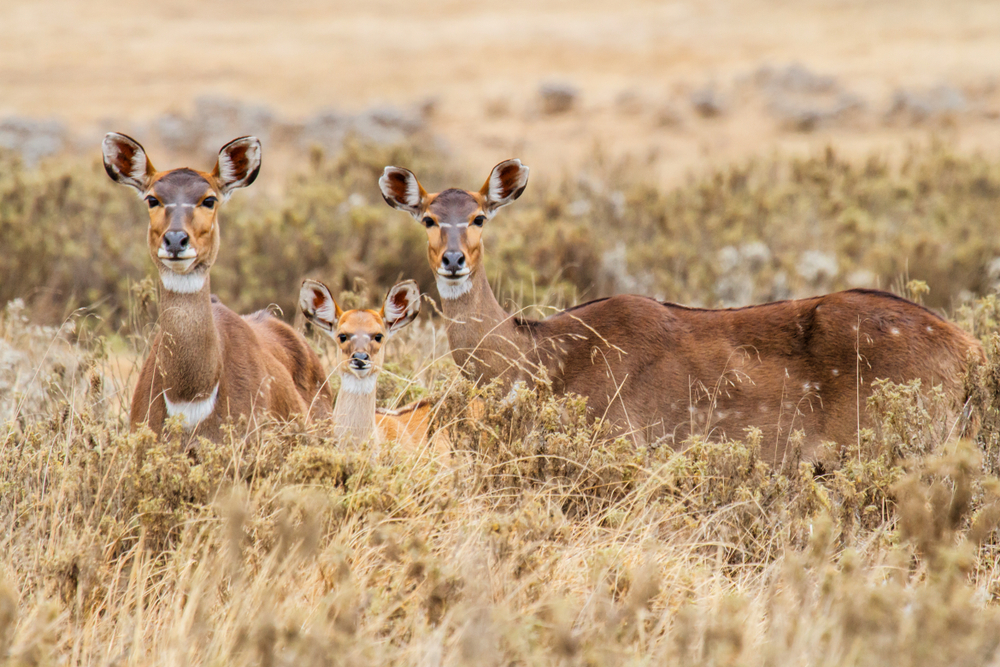Bale Mountains National Park is located a little south of the central part of Ethiopia southeast of Addis Ababa. The park covers an area of 830.12 square miles (2,150 sq km). It is almost directly south of Simien Mountains National Park.
The national park encompasses a portion of the Bale Mountains and the Sanetti Plateau, which is part of the Ethiopian Highlands. The Bale Mountains are part of the Bale-Arsi massif.
The highlands are comprised of the extensive lava Sanetti Plateau that features six different volcanic cones. Much of the landscape is blanketed with remnants of volcanic activity including trachyte, rhyolites, and basalts.
The mountains give way to multiple rivers that feed into five significant rivers which include Dumal, Ganale, Wabe Shebele, Web, and Welmel. The abundant rainfall and riverine water sources give way to a variety of vegetation.
The park features northern grasslands, northern woodlands, Afro-alpine meadows, Erica Moorlands, and the Harenna Forest. These five habitats vary depending on elevation which ranges from 9,800 feet (3,000 m) to 14,360 feet (4,377 m) above sea level.
These habitats provide a safe haven for an abundance and variety of wildlife, which in some cases is found nowhere else in the world. The national park is reported to have one of the greatest percentages of endemic species in the world. Around a quarter of all Ethiopian’s endemic species are located within Bale Mountains National Park.
Some of the most popular wildlife predator species include lion, leopard, African wild dog, hyena, African golden wolf, and the Ethiopian wolf. Some of the other popular species include mountain nyala, giant forest hog, reedbuck, klipspringer, duiker, bushbuck, warthog, and the colobus monkey.
Photos
Things to See
Bale Mountains National Park Trails
The national park is well established for hiking and exploring. There are hiking opportunities that range from a single day outing up to over 10 days of hiking, camping, and exploring. These trails will meander through the thick jungle and over the mountains while giving you chances to see lakes, rivers, and waterfalls. Of course, you will also trek the journey with hopes of witnessing the abundant species of birds and wildlife.
Sources
- African Wildlife Foundation, Ethiopian Wolf, https://www.awf.org/wildlife-conservation/ethiopian-wolf, retrieved July 2020.
- Bale Mountains, Bale Mountains National Park Site, https://www.britannica.com/place/Bale-Mountains, retrieved July 2020.
- Britannica, National Park, https://www.britannica.com/place/Virgin-Islands-Coral-Reef-National-Monument, retrieved July 2020.
- EthioVisit, Bale Mountains National Park, https://www.ethiovisit.com/bale-mountains-national-park/5/, retrieved July 2020.
- Lonely Planet, Bale Mountains National Park, https://www.lonelyplanet.com/ethiopia/southern-ethiopia/bale-mountains-national-park, retrieved July 2020.
- The Adventurist, Visiting the Bale Mountains National Park, https://theadventourist.com/visiting-bale-mountains-national-park-ethiopia, retrieved July 2020.
- UNESCO, Bale Mountains National Park, https://whc.unesco.org/en/tentativelists/5315/, retrieved July 2020.
- Wikipedia, Ethiopian Wolf, https://en.wikipedia.org/wiki/Ethiopian_wolf, retrieved July 2020.











 The Ethiopian Wolf is an endangered species and is considered the rarest canid in the world. It is estimated that only 400 individuals are currently living and about half of that population is found within the national park.
The Ethiopian Wolf is an endangered species and is considered the rarest canid in the world. It is estimated that only 400 individuals are currently living and about half of that population is found within the national park.